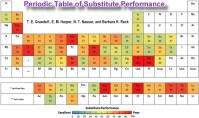|
 In a Scientific American article
titled "Elemental Urgency,"
Jennifer Hackett
reported on a paper published in 2013 by Yale University's
Thomas Graedel
et al regarding the availability (or unavailability) of the raw elements - and suitable
substitutes - used extensively in modern manufacturing. Unlike half a century ago
when most products were made from relatively common and easily obtainable elements
like lead, iron, tin, nickel, aluminum, carbon, zinc, silicon, and even silver and
gold, many more elements are now regularly included in mass manufacturing processes.
Rhenium (Re),
used in high strength, temperature alloys to applications like jet engine turbine
blades and as a catalyst in chemical processes, is one of the most critically rated
elements for uniqueness. Ditto for titanium.
Yttrium (Y), used
in the familiar YIG oscillator and YAG laser, is another critical element. Keep
in mind that this chart rates elements not solely according to scarcity, but how
critical they are in processes where no other element can be substituted in the
event of a shortage. Lead (Pb) is a clear example of an element that is abundantly
available, but the materials in which it is used cannot be easily replaced with
another element. Compounding the issue is the rate at which product manufacturing
is increasing over time, which requires a rapidly expanding availability of raw
materials. In a Scientific American article
titled "Elemental Urgency,"
Jennifer Hackett
reported on a paper published in 2013 by Yale University's
Thomas Graedel
et al regarding the availability (or unavailability) of the raw elements - and suitable
substitutes - used extensively in modern manufacturing. Unlike half a century ago
when most products were made from relatively common and easily obtainable elements
like lead, iron, tin, nickel, aluminum, carbon, zinc, silicon, and even silver and
gold, many more elements are now regularly included in mass manufacturing processes.
Rhenium (Re),
used in high strength, temperature alloys to applications like jet engine turbine
blades and as a catalyst in chemical processes, is one of the most critically rated
elements for uniqueness. Ditto for titanium.
Yttrium (Y), used
in the familiar YIG oscillator and YAG laser, is another critical element. Keep
in mind that this chart rates elements not solely according to scarcity, but how
critical they are in processes where no other element can be substituted in the
event of a shortage. Lead (Pb) is a clear example of an element that is abundantly
available, but the materials in which it is used cannot be easily replaced with
another element. Compounding the issue is the rate at which product manufacturing
is increasing over time, which requires a rapidly expanding availability of raw
materials.
Whereas a paid SciAm subscription is required to view Graedel's "The Periodic
Table of Substitute Performance" graphic (thumbnail to the
upper right), the original is freely accessed in "On the materials
basis of modern society." This abstract statement in the paper sums up the situation
alarmingly well:
"It is indisputable that modern life is enabled by the use of materials in its
technologies. Those technologies do many things very well, largely because each
material is used for purposes to which it is exquisitely fitted. The result over
time has been a steady increase in product performance. We show that this materials
complexity has markedly increased in the past half-century and that elemental life
cycle analyses characterize rates of recycling and loss. A further concern is that
of possible scarcity of some of the elements as their use increases. Should materials
availability constraints occur, the use of substitute materials comes to mind. We
studied substitution potential by generating a comprehensive summary of potential
substitutes for 62 different metals in all their major uses and of the performance
of the substitutes in those applications. As we show herein, for a dozen different
metals, the potential substitutes for their major uses are either inadequate or
appear not to exist at all. Further, for not 1 of the 62 metals are exemplary substitutes
available for all major uses."
You might be interested in a report I wrote in 2011 titled, "Afghanistan's Buried
Riches - Rare Earths & More," that helped to shed light on why it is countries
are so invested (literally) in obtaining access to even the most dangerous regions
on Earth in order to mine valuable elements and minerals. It is no doubt a large
part of the reason troops are still there after more than a decade - they are protecting
the investments of political donor companies (to Democrat, Republican, and Independent).
Posted April 4, 2022
(updated from original post on 5/31/2016)
|
 "
"